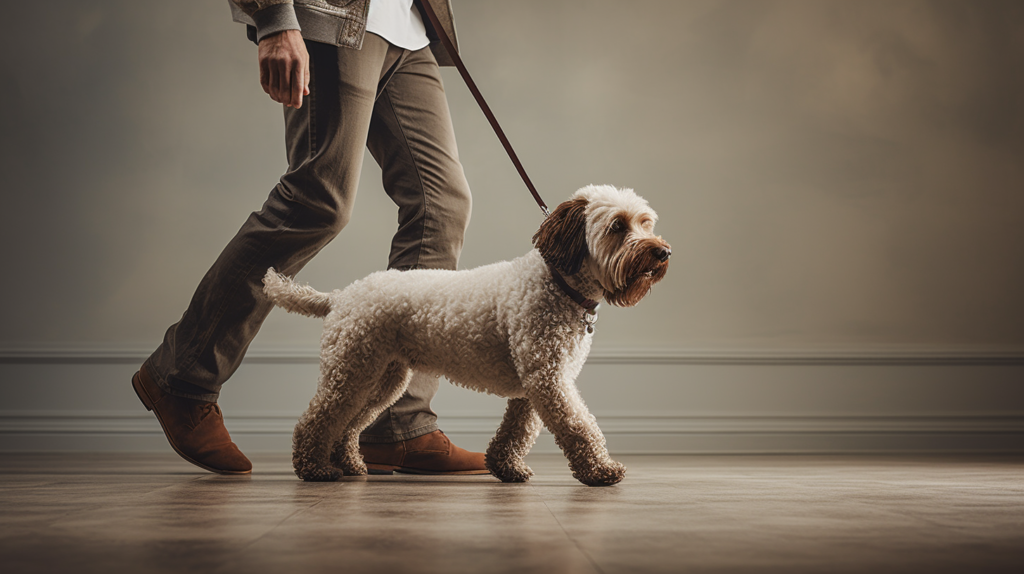- Key Takeaways
- Understanding the Importance of the 'Piede' Command
- Teaching Your Dog to Walk Calmly and Closely
- Establishing a Strong Bond with Your Dog
- Training Techniques for Mastering the 'Piede' Command
- Troubleshooting Common Challenges
- Enjoying the Benefits of a Well-Behaved Dog
- Frequently Asked Questions
Click and GO TO THE BEST DOG NAME GENERATOR HERE

Are you tired of your dog pulling on the leash during walks? Do you dream of having a well-behaved furry companion who walks calmly and closely by your side? Look no further, because the Italian dog command ‘piede’ is here to save the day!
In this article, we will delve into the importance of mastering this command and how it can transform your daily walks. By teaching your dog to heel, not only will you have more control over their movements, but you will also establish a stronger bond with them.
We will explore various training techniques that will help you achieve success in commanding ‘piede.’ Additionally, we’ll tackle common challenges that may arise along the way and provide troubleshooting tips.
Get ready to enjoy the benefits of having a well-behaved dog who walks obediently at your side!
- Key Takeaways
- Understanding the Importance of the 'Piede' Command
- Teaching Your Dog to Walk Calmly and Closely
- Establishing a Strong Bond with Your Dog
- Training Techniques for Mastering the 'Piede' Command
- Troubleshooting Common Challenges
- Enjoying the Benefits of a Well-Behaved Dog
- Frequently Asked Questions
Key Takeaways
- The ‘Piede’ command is important for calm and close walks with your dog, as well as safety and control during walks.
- Teaching your dog to walk calmly and closely involves positive reinforcement, starting in low-distraction environments, and regular practice.
- Establishing a strong bond with your dog requires quality time, patience, positive reinforcement, and avoiding punishment or negative reinforcement techniques.
- Training techniques for mastering the ‘Piede’ command include positive reinforcement, clicker training, consistency, practicing in various environments, and establishing trust and cooperation.
Understanding the Importance of the ‘Piede’ Command
A well-trained dog that knows how to heel can prevent accidents and distractions while on a walk. Imagine being able to walk confidently in busy streets or crowded areas without having to worry about your dog pulling or getting into trouble.
A dog that stays close also allows for better communication and bonding between you and your furry friend. By mastering the ‘piede’ command, you are taking the first step towards teaching your dog to walk calmly and closely. This enhances both your walking experience and your relationship with your canine companion.
Teaching Your Dog to Walk Calmly and Closely
Mastering the art of walking calmly and closely with your furry companion is key to a harmonious stroll. When teaching your dog to walk in the ‘piede’ position, it’s important to use effective teaching techniques and maintain consistency.
Start by using positive reinforcement, rewarding your dog with treats or praise when they stay close to your side. Use a leash that allows for control but doesn’t restrict their movement too much. Practice in low-distraction environments before gradually increasing the difficulty level.
As you work on this command, remember to be patient and consistent with your expectations.
With time and practice, your dog will learn to walk calmly and closely by your side. This will not only ensure a pleasant walking experience but also establish a strong bond between you and your furry friend as you continue on your training journey towards becoming the best companions you can be.
https://www.youtube.com/watch?v=Td4H33SZzdQ
Establishing a Strong Bond with Your Dog
Building a strong bond with your canine companion is essential for a harmonious relationship. Building trust is the foundation of this bond, and it requires consistent effort and positive reinforcement.
Spend quality time with your dog, engaging in activities that they enjoy. This could include going for walks, playing fetch, or even just cuddling on the couch. Show them love, patience, and understanding as you navigate through different training exercises together.
Positive reinforcement is key in strengthening your bond with your dog. Reward their good behavior with treats, praise, and affection. This will encourage them to repeat those behaviors and deepen the connection between you two. Avoid using punishment or negative reinforcement techniques as they can damage the trust you’ve built.
By establishing a strong bond based on trust and positive reinforcement, you’ll be better equipped to teach your dog the ‘piede’ command effectively. Stay tuned for the next section where we explore training techniques for mastering this important command.
Training Techniques for Mastering the ‘Piede’ Command
Immerse yourself in training techniques that will have your furry friend walking faithfully by your side. When it comes to mastering the ‘Piede’ command, there are several effective training methods you can use.
One popular technique is positive reinforcement, which involves rewarding your dog with treats or praise when they successfully heel. Another method is clicker training, where a clicking sound is used to mark the desired behavior and then followed by a treat.
Consistency is key in reinforcing obedience during the training process. Make sure to practice the ‘Piede’ command regularly and in various environments to ensure your dog’s understanding and compliance.
By employing these training techniques, you can establish a strong bond with your canine companion based on trust and cooperation.
Transitioning into troubleshooting common challenges, remember that every dog learns at their own pace, so be patient and persistent throughout the process of teaching them the ‘Piede’ command.
Troubleshooting Common Challenges
Having trouble with getting your furry companion to walk obediently by your side? Let’s tackle some common challenges together!
When training your dog in the ‘piede’ command, it’s important to address distractions that may arise. Dogs can easily get distracted by other animals, people, or even interesting smells. To overcome this, start training in a quiet environment and gradually introduce distractions as your dog becomes more proficient.
Additionally, stubborn dogs may require some extra patience and persistence during training. Try using high-value treats or toys as rewards to motivate them. Consistency is key, so make sure to practice the ‘piede’ command regularly and praise your dog for their progress.
By addressing distractions and implementing effective techniques for stubborn dogs, you’ll be one step closer to enjoying the benefits of a well-behaved canine companion.
Enjoying the Benefits of a Well-Behaved Dog
Now that you have tackled some of the common challenges in training your dog to follow the Italian command ‘piede’ or heel, it’s time to focus on enjoying the benefits of a well-behaved pup.
Consistency is key when it comes to building trust through positive reinforcement. By consistently using the ‘piede’ command and rewarding your furry friend for walking politely by your side, you are not only teaching them good manners but also strengthening your bond.
A well-behaved dog brings numerous benefits, such as enhanced safety during walks, improved social interactions with other dogs and people, and a sense of pride in being a responsible pet owner.
Remember, training is an ongoing process, so continue reinforcing good behavior and watch as your canine companion becomes a true joy to be around.
Frequently Asked Questions
How long does it usually take for a dog to learn the ‘Piede’ command?
To troubleshoot common issues when teaching the ‘piede’ command, ensure you have a clear understanding of the technique. Maintain consistency by practicing daily and using positive reinforcement. Most dogs learn the command within a few weeks with consistent training.
Can the ‘Piede’ command be taught to dogs of any age or breed?
Yes, the ‘piede’ command can be taught to dogs of any age or breed. While older dogs may take longer to learn, consistent training and positive reinforcement can help them understand. Some breeds that struggle with obedience may require extra patience and specialized techniques.
Is it necessary to use treats or rewards during the training process?
Yes, alternative methods such as praise and play can be used instead of treats or rewards in dog training. To phase out the use of treats or rewards once the dog has learned the ‘piede’ command, gradually decrease their frequency while increasing verbal praise and physical affection.
What are some common mistakes that dog owners make when teaching the ‘Piede’ command?
When teaching the ‘piede’ command, common mistakes include inconsistent reinforcement, lack of patience, and using punishment. Instead, use positive reinforcement consistently, be patient with your dog’s progress, and break the training into small steps for effective learning.
Can the ‘Piede’ command be used in different situations, such as during walks or at the dog park?
During walks, you can reinforce the ‘piede’ command by using a leash and giving verbal cues. This helps establish control and keeps your dog focused. At the dog park, incorporating ‘piede’ into off-leash training enhances obedience and safety.
Check out the other key Italian Dog Commands to train your doggy Ciao
Italian Dog Commands: Seduto (Sit)
Italian Dog Commands: Vieni (Come)
Italian Dog Commands: Resta (Stay)
Italian Dog Commands: Piede (Heel)
Italian Dog Commands: Dai la zampa (Shake hands)
Italian Dog Commands: No (No)
Italian Dog Commands: Si (Yes)
Italian Dog Commands: Basta (Enough/Stop)
Italian Dog Commands: Cerca (Search)
Italian Dog Commands: Guarda (Watch)
- Key Takeaways
- Understanding the Importance of the 'Piede' Command
- Teaching Your Dog to Walk Calmly and Closely
- Establishing a Strong Bond with Your Dog
- Training Techniques for Mastering the 'Piede' Command
- Troubleshooting Common Challenges
- Enjoying the Benefits of a Well-Behaved Dog
- Frequently Asked Questions


